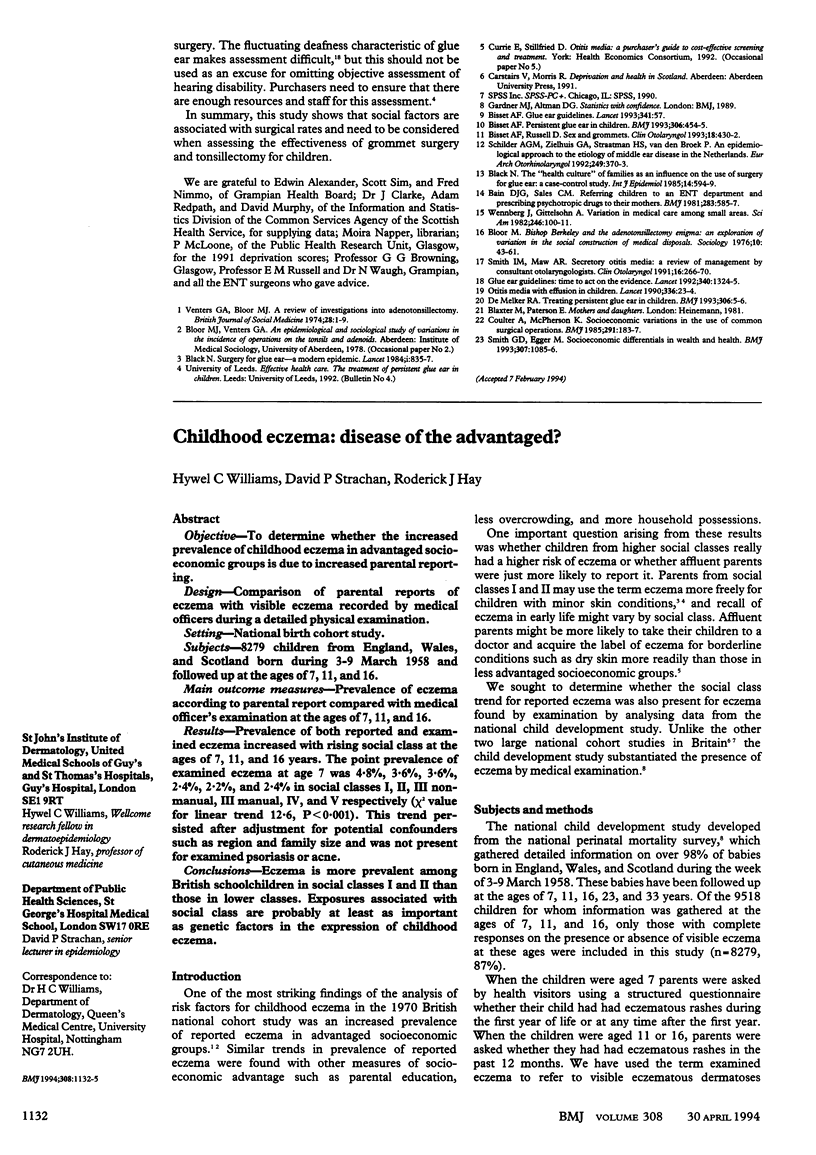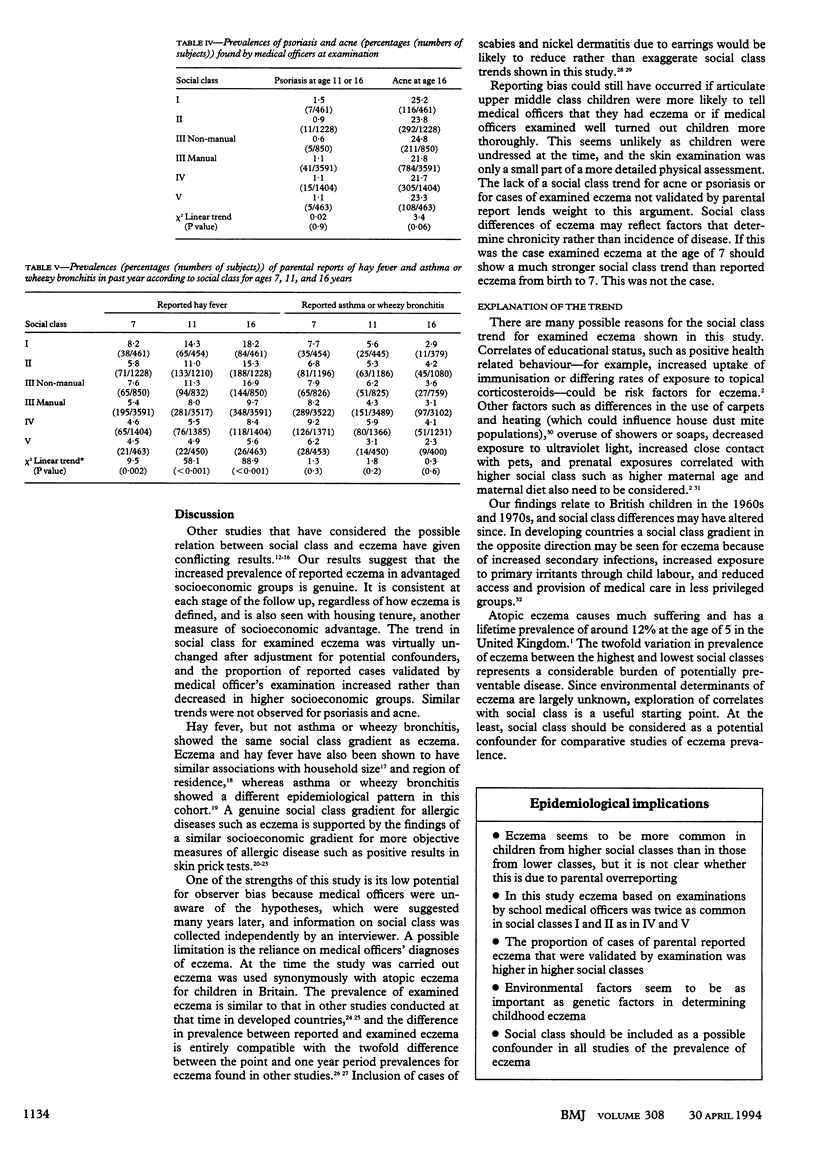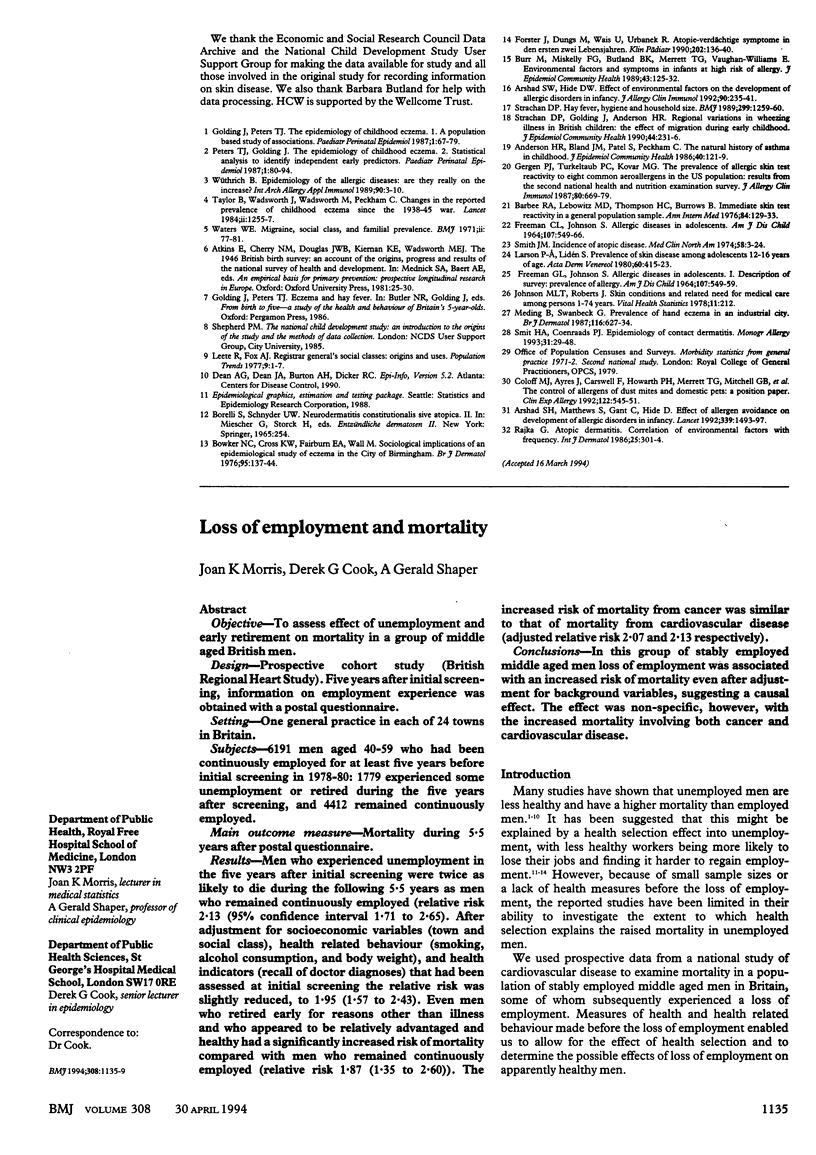Abstract
OBJECTIVE--To determine whether the increased prevalence of childhood eczema in advantaged socioeconomic groups is due to increased parental reporting. DESIGN--Comparison of parental reports of eczema with visible eczema recorded by medical officers during a detailed physical examination. SETTING--National birth cohort study. SUBJECTS--8279 children from England, Wales, and Scotland born during 3-9 March 1958 and followed up at the ages of 7, 11, and 16. MAIN OUTCOME MEASURES--Prevalence of eczema according to parental report compared with medical officer's examination at the ages of 7, 11, and 16. RESULTS--Prevalence of both reported and examined eczema increased with rising social class at the ages of 7, 11, and 16 years. The point prevalence of examined eczema at age 7 was 4.8%, 3.6%, 3.6%, 2.4%, 2.2%, and 2.4% in social classes I, II, III non-manual, III manual, IV, and V respectively (chi 2 value for linear trend 12.6, P < 0.001). This trend persisted after adjustment for potential confounders such as region and family size and was not present for examined psoriasis or acne. CONCLUSIONS--Eczema is more prevalent among British schoolchildren in social classes I and II than those in lower classes. Exposures associated with social class are probably at least as important as genetic factors in the expression of childhood eczema.
Full text
PDF



Selected References
These references are in PubMed. This may not be the complete list of references from this article.
- Anderson H. R., Bland J. M., Patel S., Peckham C. The natural history of asthma in childhood. J Epidemiol Community Health. 1986 Jun;40(2):121–129. doi: 10.1136/jech.40.2.121. [DOI] [PMC free article] [PubMed] [Google Scholar]
- Arshad S. H., Hide D. W. Effect of environmental factors on the development of allergic disorders in infancy. J Allergy Clin Immunol. 1992 Aug;90(2):235–241. doi: 10.1016/0091-6749(92)90077-f. [DOI] [PubMed] [Google Scholar]
- Arshad S. H., Matthews S., Gant C., Hide D. W. Effect of allergen avoidance on development of allergic disorders in infancy. Lancet. 1992 Jun 20;339(8808):1493–1497. doi: 10.1016/0140-6736(92)91260-f. [DOI] [PubMed] [Google Scholar]
- Barbee R. A., Lebowitz M. D., Thompson H. C., Burrows B. Immediate skin-test reactivity in a general population sample. Ann Intern Med. 1976 Feb;84(2):129–133. doi: 10.7326/0003-4819-84-2-129. [DOI] [PubMed] [Google Scholar]
- Bowker N. C., Cross K. W., Fairburn E. A., Wall M. Sociological implications of an epidemiological study of eczema in the City of Birmingham. Br J Dermatol. 1976 Aug;95(2):137–144. doi: 10.1111/j.1365-2133.1976.tb00816.x. [DOI] [PubMed] [Google Scholar]
- Burr M. L., Miskelly F. G., Butland B. K., Merrett T. G., Vaughan-Williams E. Environmental factors and symptoms in infants at high risk of allergy. J Epidemiol Community Health. 1989 Jun;43(2):125–132. doi: 10.1136/jech.43.2.125. [DOI] [PMC free article] [PubMed] [Google Scholar]
- FREEMAN G. L., JOHNSON S. ALLERGIC DISEASES IN ADOLESCENTS. I. DESCRIPTION OF SURVEY; PREVALENCE OF ALLERGY. Am J Dis Child. 1964 Jun;107:549–559. doi: 10.1001/archpedi.1964.02080060551001. [DOI] [PubMed] [Google Scholar]
- FREEMAN G. L., JOHNSON S. ALLERGIC DISEASES IN ADOLESCENTS. I. DESCRIPTION OF SURVEY; PREVALENCE OF ALLERGY. Am J Dis Child. 1964 Jun;107:549–559. doi: 10.1001/archpedi.1964.02080060551001. [DOI] [PubMed] [Google Scholar]
- Forster J., Dungs M., Wais U., Urbanek R. Atopie-verdächtige Symptome in den ersten zwei Lebensjahren. Einfluss von Geburtsreife, Ernährung und Sozialstatus. Klin Padiatr. 1990 May-Jun;202(3):136–140. doi: 10.1055/s-2007-1025506. [DOI] [PubMed] [Google Scholar]
- Gergen P. J., Turkeltaub P. C., Kovar M. G. The prevalence of allergic skin test reactivity to eight common aeroallergens in the U.S. population: results from the second National Health and Nutrition Examination Survey. J Allergy Clin Immunol. 1987 Nov;80(5):669–679. doi: 10.1016/0091-6749(87)90286-7. [DOI] [PubMed] [Google Scholar]
- Golding J., Peters T. J. The epidemiology of childhood eczema: I. A population based study of associations. Paediatr Perinat Epidemiol. 1987 Apr;1(1):67–79. doi: 10.1111/j.1365-3016.1987.tb00091.x. [DOI] [PubMed] [Google Scholar]
- Larsson P. A., Lidén S. Prevalence of skin diseases among adolescents 12--16 years of age. Acta Derm Venereol. 1980;60(5):415–423. [PubMed] [Google Scholar]
- Meding B., Swanbeck G. Prevalence of hand eczema in an industrial city. Br J Dermatol. 1987 May;116(5):627–634. doi: 10.1111/j.1365-2133.1987.tb05895.x. [DOI] [PubMed] [Google Scholar]
- Peters T. J., Golding J. The epidemiology of childhood eczema: II. Statistical analyses to identify independent early predictors. Paediatr Perinat Epidemiol. 1987 Apr;1(1):80–94. doi: 10.1111/j.1365-3016.1987.tb00092.x. [DOI] [PubMed] [Google Scholar]
- Rajka G. Atopic dermatitis. Correlation of environmental factors with frequency. Int J Dermatol. 1986 Jun;25(5):301–304. doi: 10.1111/j.1365-4362.1986.tb02249.x. [DOI] [PubMed] [Google Scholar]
- Smit H. A., Coenraads P. J. Epidemiology of contact dermatitis. Monogr Allergy. 1993;31:29–48. [PubMed] [Google Scholar]
- Smith J. M. Incidence of atopic disease. Med Clin North Am. 1974 Jan;58(1):3–24. doi: 10.1016/s0025-7125(16)32173-3. [DOI] [PubMed] [Google Scholar]
- Strachan D. P., Golding J., Anderson H. R. Regional variations in wheezing illness in British children: effect of migration during early childhood. J Epidemiol Community Health. 1990 Sep;44(3):231–236. doi: 10.1136/jech.44.3.231. [DOI] [PMC free article] [PubMed] [Google Scholar]
- Strachan D. P. Hay fever, hygiene, and household size. BMJ. 1989 Nov 18;299(6710):1259–1260. doi: 10.1136/bmj.299.6710.1259. [DOI] [PMC free article] [PubMed] [Google Scholar]
- Taylor B., Wadsworth J., Wadsworth M., Peckham C. Changes in the reported prevalence of childhood eczema since the 1939-45 war. Lancet. 1984 Dec 1;2(8414):1255–1257. doi: 10.1016/s0140-6736(84)92805-8. [DOI] [PubMed] [Google Scholar]
- Waters W. E. Migraine: intelligence, social class, and familial prevalence. Br Med J. 1971 Apr 10;2(5753):77–81. doi: 10.1136/bmj.2.5753.77. [DOI] [PMC free article] [PubMed] [Google Scholar]


